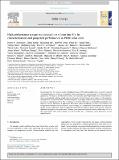High-performance p-type multicrystalline silicon (mc-Si): Its characterization and projected performance in PERC solar cells
Author(s)
Altermatt, Pietro P.; Xiong, Zhen; He, QuiXiang; Deng, WeiWei; Ye, Feng; Yang, Yang; Chen, Yifeng; Feng, ZhiQiang; Verlinden, Pierre J.; Liu, Anyao; Macdonald, Daniel H.; Luka, Tabea; Lausch, Dominik; Turek, Marko; Hagendorf, Christian; Wagner-Mohnsen, Hannes; Schon, Jonas; Kwapil, Wolfram; Fruhauf, Felix; Breitenstein, Otwin; Looney, Erin Elizabeth; Buonassisi, Anthony; Needleman, David Berney; Jackson, Christine M.; Arehart, Aaron R.; Ringel, Steven A.; McIntosh, Keith R.; Abbott, Malcolm D.; Sudbury, Ben A.; Zuschlas, Annika; Winter, Clemens; Skorka, Daniel; Hahn, Giso; Chung, Daniel; Mitchell, Bernhard; Geelan-Small, Peter; Trupke, Thorsten; ... Show more Show less
DownloadAccepted version (1.304Mb)
Publisher with Creative Commons License
Publisher with Creative Commons License
Creative Commons Attribution
Terms of use
Metadata
Show full item recordAbstract
© 2018 Elsevier Ltd Recent progress in the electronic quality of high-performance (HP) multicrystalline silicon material is reported with measurements and modeling performed at various institutions and research groups. It is shown that recent progress has been made in the fabrication at Trina Solar mainly by improving the high excess carrier lifetimes τ due to a considerable reduction of mid-gap states. However, the high lifetimes in the wafers are still reduced by interstitial iron by a factor of about 10 at maximum power point (mpp) conditions compared to mono-crystalline Cz wafers of equivalent resistivity. The low lifetime areas of the wafers seem to be limited by precipitates, most likely Cu. Through simulations, it appears that dislocations reduce cell efficiency by about 0.25% absolute. The best predictors for PERC cell efficiency from ingot metrology are a combination of mean lifetime and dislocation density because dislocations cannot be improved considerably by gettering during cell processing, while lifetime-limiting impurities are gettered well. In future, the material may limit cell efficiency above about 22.5% if the concentrations of Fe and Cu remain above 1010 and 1013 cm−3, respectively, and if dislocations are not reduced further.
Date issued
2018Department
Massachusetts Institute of Technology. Department of Mechanical EngineeringJournal
Solar Energy
Publisher
Elsevier BV